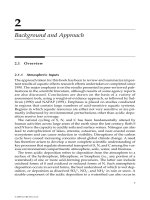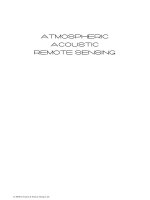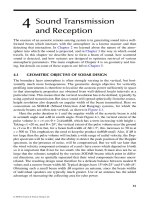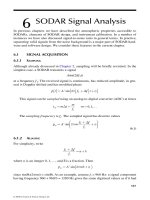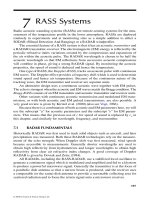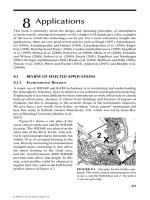Atmospheric Acoustic Remote Sensing - Chapter 2 potx
Bạn đang xem bản rút gọn của tài liệu. Xem và tải ngay bản đầy đủ của tài liệu tại đây (239.89 KB, 15 trang )
11
2
The Atmosphere
Near the Ground
Atmospheric acoustic remote-sensing instruments are designed to give reliable mea-
surements near the ground of atmospheric properties, such as wind speed, wind
direction, turbulence intensity, and temperature. Estimates of these properties, in
remote volumes up to several hundreds of meters above the ground, are obtained
using a ground-based installation. Proles of the atmosphere obtained in this way
are then used for interpretation of atmospheric dynamics or transport mechanisms,
and the results applied to the understanding of processes, such as wind power gen-
eration or urban pollution.
Effective design and use of acoustic remote-sensing instruments must therefore
be coupled with some understanding of the lower atmosphere and the interrelation-
ship between atmospheric properties. In this chapter, the structure of temperature,
wind, and turbulence near the ground is discussed. Some general references cover-
ing this material are Blackadar (1998), Kaimal and Finnigan (1994), Panofsky and
Dutton (1984), and Stull (1988).
2.1 TEMPERATURE PROFILES NEAR THE SURFACE
The atmospheric layer closest to the surface is strongly coupled to surface proper-
ties through friction. This friction-dominated planetary boundary layer is normally
about 3 km deep, and vertical transport of heat, moisture, and momentum through
the layer largely determines weather and climate. This is also the region most acces-
sible to acoustic remote sensing.
Atmospheric pressure is due to the weight of air above, and so decreases with
height. Near the surface, the air density S does not change signicantly with height
(a typical value is 1.2 kg m
–3
), the hydrostatic equation ∆p
atm
=−Sg∆z gives the pres-
sure decrease ∆p
atm
for a height increase ∆z, and g is the gravitational acceleration.
If air rises or sinks, it will therefore expand or compress. Such pressure changes are
accompanied by temperature changes, such as the heating that occurs in a bicycle
pump when the air is compressed. However, because air is a poor heat conductor,
vertically moving air does not exchange heat very effectively with the surrounding
air. For a mass of air rising small distance dz, the change in potential energy g dz
per unit mass of air is balanced by a change c
p
dT in its internal heat energy, where
c
p
is the specic heat and dT is the change in temperature of the air. The result is the
adiabatic lapse rate
d
d
ms
Jkg K
C cooling
T
z
g
c
p
981
1005
98
2
11
.
.
C
pper km of a ltitude.
© 2008 by Taylor & Francis Group, LLC
12 Atmospheric Acoustic Remote Sensing
Potential temperature, 2, is a temperature measure with the natural 9.8°C per
km removed, T is generally expressed in °C, and 2 is usually expressed in K. Near
the surface, changes in the two temperature measures are related through
$$ $O Tz(. )0 0098
C
C/m
(2.1)
On average, cooling is less rapid than the adiabatic rate because of absorption by
the air of heat radiated from the ground and because of mixing of air by turbulence.
A typical lapse rate, used to dene a standard atmosphere for computer models,
is 6.5°C per km. So at any particular location and time, the environmental lapse
rate will usually be different from the adiabatic lapse rate. If the environment cools
more rapidly with height than 9.8°C per km, then rising air will be surrounded by
cooler air and so will continue to rise: this is an unstable or lapse atmosphere and
dd1/ z 0. If the environment cools less rapidly with height than 9.8°C per km,
then rising air will be surrounded by warmer air and so will sink: this is a stable
or inversion atmosphere for which dd1/ z 0. If the surface is heated by the sun,
then air in contact will be hotter than the environment and will rise: this convec-
tion occurs during sunny days. When convective or wind-driven mixing of air is
strong, the lapse rate will be close to adiabatic: this is the neutral atmosphere and
dd1/ z 0 . Neutral and stable cases are shown in Figure 2.1.
A common occurrence is overnight cooling of the surface by radiating heat into
a cold clear sky, and the cooling of the air closest to the surface through weak tur-
bulent mixing. This creates a strongly stable layer of air in contact with the surface
so that the environmental temperature initially increases with height. This region
of increasing potential temperature with height is called a temperature inversion.
z (m)
95 100 105 110 p
atm
(kPa)
T, Θ (°C)
90
0
200
400
600
800
1000
0 5 10 15 20
FIGURE 2.1 Height dependence of temperature, T (lled triangles for neutral or adiabatic
case; lled circles for stable or average case), potential temperature, 2 (open triangles for
neutral case; open circles for stable case), and pressure, p (solid line), in the lowest km.
© 2008 by Taylor & Francis Group, LLC
The Atmosphere Near the Ground 13
At some height, the surface cooling effect will be insignicant and the temperature
will again decrease with height. Inversions also occur at the top of fog where the
droplets radiate heat in a similar manner to a solid surface, and also sometimes when
one layer of air moves over another and their temperature structures are different.
Inversions are important because pollutants, heat, and moisture become trapped in
the underlying stable air.
Because the environmental lapse rate determines the vigor of vertical motion in
the atmosphere, measurements of temperature proles are very important in under-
standing and predicting atmospheric dynamics. Radio-Acoustic Sounding Systems
(RASSs) are very useful as continuous measurement systems, whereas balloon
soundings are generally used to obtain temperature proles extending throughout
the atmosphere.
2.2 WIND PROFILES NEAR THE SURFACE
Winds are slowed near the surface because of friction and obstacles, such as trees
and hills. The action of different winds at two heights (wind shear) causes overturn-
ing which leads to smaller scale random motion or turbulence.
Usually, the wind velocity is visualized as consisting of components u, v, and w in the
perpendicular x, y, and z directions, where x and y are horizontal (e.g., East and North) and
z increases vertically. The total horizontal wind speed is Vuv
22
. The instanta-
neous components can be written as uuu
`
, vvv
`
, and www
`
where
the mean value is shown with an overbar and the uctuating turbulent value is shown with
a prime (Fig. 2.2).
Even when there is no mean vertical velocity component, turbulent uctuations
`
w will transfer heat, moisture, and momentum vertically. For example, the average
rate at which the u momentum is transported vertically, per unit horizontal area, is
R
``
uw . The quantity
R
``
uw is the average momentum ux of u momentum in the
–2
0
2
4
6
8
10
0246810
FIGURE 2.2 Typical time series of wind components u (dark line), v (dotted line), and w
(thin line) showing mean and uctuating parts.
© 2008 by Taylor & Francis Group, LLC
14 Atmospheric Acoustic Remote Sensing
z-direction, and its value determines what the turbulent connection is between the
low-speed air near the surface and the higher-speed air aloft. The momentum ux
can be measured directly by a sonic anemometer, which can measure simultaneously
the 3-component wind uctuations and form products such as
``
uw and then aver-
age over a time interval.
In the lowest 10 m, a mixing length model describes this wind and turbulence
interaction quite well. The small turbulent patches carry momentum from one level
to another, but after moving a short vertical distance l (the mixing length) these
patches break down. So the
`
u carried from level z to level z + l accounts for the
difference in the average horizontal wind speed at the two levels, or
d
d
u
z
u
l
`
.
Also, if the turbulence is isotropic (the same in all directions), then
||||
`
`
wu
and, allowing for the direction of transport,
``
¤
¦
¥
¥
¥
´
¶
µ
µ
µ
µ
uw l
u
z
2
2
d
d
. (2.2)
The simplest assumption is that the layer is a constant ux layer and therefore write
``
uw u
2
, (2.3)
where the friction velocity u
*
is a constant. The vertical distance in which overturn-
ing can occur is limited by how close the turbulent patch is to the ground, so it is
assumed that
lz
m
K , (2.4)
where L
m
is called the von Karman constant, which is found to have a value of about
0.4. Integrating leads to a logarithmic wind speed variation with height:
u
uz
z
m
¤
¦
¥
¥
¥
¥
´
¶
µ
µ
µ
µ
K
ln .
0
(2.5)
The roughness length z
0
depends on how rough the surface is. In this approxi-
mation, the wind speed decreases to zero at a height
z
0
. Typical cases are shown
in Figure 2.3, where
u
*
=0.25ms
–1
and z
0
= 0.01 m for snow, 0.05 m for pas-
ture, and 3 m for forest. A
u
*
value of 0.25 m s
–1
is equivalent to an upward ux
of momentum of –1.2(0.25)
2
= –0.075 kg m
–1
s
–2
, since the density of air at the
ground is about S1.2 kg m
–3
.
The mixing length approximation is only valid for neutral conditions and only
in the lowest few tens of meters where the vertical ux of momentum is approxi-
mately constant. Above this constant ux layer, a useful approach is to assume that
more momentum is transported vertically if the wind speed gradient is stronger. The
© 2008 by Taylor & Francis Group, LLC
The Atmosphere Near the Ground 15
assumption is therefore made that the momentum ux is proportional to the wind
speed gradient or
``
uw K
u
z
m
d
d
, (2.6)
where the constant K
m
is the coefcient of eddy viscosity and typically is 1 to
100 m
2
s
–1
. Well above the frictional inuence of the surface, the wind speed and
direction are determined only by the pressure gradient (due to low-pressure or high-
pressure systems) and the spinning of the earth (through the Coriolis effect). The
latter effect means that the vertical ux of east-west momentum is fed into changes
in the north-south wind component, and vice versa, leading to a twisting of the wind
direction with height. This is the Ekman spiral, in which the wind V is small at the
surface and its direction %G is 45° anticlockwise near the surface compared to V
c
the wind aloft (or clockwise in the southern hemisphere). Equations for speed and
direction are found to be
VV
z
L
zL zL
¤
¦
¥
¥
¥
¥
´
¶
µ
µ
µ
µ
∞
12
2
1
ee
PP
P
//
cos
EE
E
//
/
/
,tan
sin
cos
2
1
1
$F
P
P
P
P
¤
e
e
E
E
zL
zL
z
L
z
L
E
E
¦¦
¥
¥
¥
¥
¥
¥
¥
¥
¥
¥
´
¶
µ
µ
µ
µ
µ
µ
µ
µ
µ
µ
µ
µ
,
(2.7)
0
2
4
6
8
10
012345
FIGURE 2.3 Height dependence of wind speed, u, from the mixing length theory, over
trees (crosses), pasture (circles), and snow (squares) in the rst 10 m above the surface.
© 2008 by Taylor & Francis Group, LLC
16 Atmospheric Acoustic Remote Sensing
where LK
mE
P /|sin|7& depends on K
m
and on the Coriolis effect through
the angular velocity of rotation of the Earth, 8 =7.29×10
–5
s
–1
, and the latitude '.
Since the deviation in wind direction becomes zero at height L
E
, this height can be
considered as an approximate depth of the boundary layer. Eq. (2.7) is a little hard to
interpret by visual inspection. For small heights z, approximate equations are
VV
z
L
z
L
¤
¦
¥
¥
¥
¥
´
¶
µ
µ
µ
µ
∞
P
F
EE
, $ 45 1
2
C
(2.8)
so that the speed increases linearly with height and the deviation from the overlay-
ing wind direction is initially 45° and linearly decreasing toward zero. Figure 2.4
shows an Ekman spiral for V
c
10
1
ms and L
E
= 1 km (e.g., corresponding to
K
m
=5m
2
s
–1
at a latitude of 43°).
Although useful in models, both the mixing length and Ekman approxima-
tions are generally far too much of a simplication, and the wind structure near the
surface needs to be measured or derived using additional information. This is one of
the reasons that SODARs prove so useful.
2.3 RICHARDSON NUMBER
The momentum ux
R
``
uw
is the rate of transfer of momentum per unit horizon-
tal area. It therefore also represents a force per unit area or a stress. The product of
force and velocity is a rate of doing work or a rate of change of energy. In the case
of
0
200
400
600
800
1000
0 10203040
FIGURE 2.4 The wind speed in m s
–1
(dark line) and wind direction in degrees (thin line)
versus height in m for an Ekman spiral with a wind speed aloft of 10 m s
–1
. The wind barbs
on the right-hand side indicate direction from arrow barb to arrow point and speed by adding
half barbs (1 m s
–1
), full barbs (2 m s
–1
), and lled triangles (5 m s
–1
).
© 2008 by Taylor & Francis Group, LLC
The Atmosphere Near the Ground 17
``
¤
¦
¥
¥
¥
¥
´
¶
µ
µ
µ
µ
uw
du
dz
K
du
dz
m
2
the product represents the rate at which turbulent energy is transferred to the mean
ow (per unit mass of air).
In a similar way to velocity uctuations, the air temperature can be written as
TTT
`
(in many of the denitions which follow, the uctuation in potential
temperature 2b is commonly used instead of Tb: the two are essentially the same).
An increase in temperature by amount Tb means that the volume of air will be less
dense and more buoyant (at constant pressure, density and temperature are inversely
related). The force per unit volume on the air will be
`
`
RRgT Tg(/)
. Again, the
average rate of doing work by the buoyancy forces, per unit volume, will be the prod-
uct of force and velocity, in this case
R
``
wTg T/
. Per unit mass of air, this becomes
``
wT g T/ . The ux Richardson number is
R
wT g T
Kuz
f
m
``
/
(/)
.
dd
2
(2.9)
When the numerator is positive, the temperature prole is unstable (warmer air
is being carried upward by vertical velocity uctuations), and R
f
is negative. For
stable temperature proles, R
f
is positive, and in this case the temperature stratica-
tion tends to reduce the turbulent uctuations. When the ux Richardson number
becomes greater than 1, the ow becomes dynamically stable and turbulence tends
to decay.
The heat ux H can be written in terms of the temperature gradient through
HcwT cK
z
pph
``
RR
d
d
1
(2.10)
and is used to dene the (bulk) Richardson number
R
g
T
z
uz
PR
irf
dd
dd
1 /
(/)
.
2
(2.11)
2.4 THE PRANDTL NUMBER
P
K
K
r
m
h
(2.12)
has a value of about 0.7. Strongly stable air or low wind shear will therefore pro-
duce higher values of R
i
and turbulence will be suppressed. In practice, it is found
if a critical Richardson number of R
i
> 0.25 is exceeded, then turbulence does not
© 2008 by Taylor & Francis Group, LLC
18 Atmospheric Acoustic Remote Sensing
occur. Note that if R
i
is negative, then the temperature prole is unstable. A single
sonic anemometer can measure
``
uw
and
``
wT
directly but only infer
dduz/
. A
SODAR can measure
dduz/
directly and a RASS can directly obtain
dd1/ z
, so
the SODAR/RASS combination can obtain R
i
proles directly. The main reason for
using the Ri, rather than Rf, is that the Richardson number includes terms which are
much more easily directly measured.
2.5 THESTRUCTUREOF TURBULENCE
The cascade theory of turbulence assumes that the vertical gradient of the wind, or
wind shear, arising from surface friction initially causes turbulent vortices of size L
0
(the outer scale). These are assumed to break down into successively smaller vorti-
ces (in a “cascade”) until they become a small size l
0
(the inner scale) and then their
energy is dissipated as heat. The essential idea is that turbulent kinetic energy (TKE)
enters at large scales at a certain rate dependent on the generating mechanism, and
is conserved as the turbulent scale sizes get smaller, and eventually dissipates at a
rate F per unit mass of air. The sizes of the turbulent patches are usually specied
in terms of wavenumber L =2Q/size. The idea of the cascade is that '
V
, the kinetic
energy (KE) per unit mass in a unit wavenumber interval, must be related to the rate,
F, at which KE per unit mass is dissipated as heat, and also related to wavenumber L
because there would be expected to be more smaller eddies in a volume than large
ones. Assuming that F appears to the power p and L to the power q,
&
V
pq
( ) { ( )} { ( )} .Jkg m Jkg s m
1111
| EK
Also 1J=1kgm
2
s
–2
, so equating mass, length, and time dimensions gives
m
3
s
–2
=m
2p–q
s
–3p
or
&
V
15
23 53
.,
//
EK (2.13)
where 1.5 is an empirical constant. This is Kolmogorov’s famous 5/3 law for the tur-
bulent energy spectrum. In practice this means that, for turbulent patches with sizes
in the range l
0
to L
0
, the KE spectrum needs to be known at only one wavenumber
interval in order to characterize the entire turbulent energy spectrum. However,
the scale factor for the energy spectrum, F
2/3
, will vary at different sites and times
depending on the rate at which turbulent energy is injected into the atmosphere at
scales L
0
(typically 100 m), and lost as heat at scales l
0
(typically a few mm).
The turbulent energy dissipation rate F is not easily measured directly. Dimen-
sionally F
2/3
is equivalent to (m s
–1
)
2
m
–2/3
or a velocity squared divided by a length to
the 2/3 power. A more easily measured quantity having this character is
C
Vx V
xx
tt
Vxt V
V
2
2
23 23
21
011
0
[() ()]
[(,) (
//
,, ) ] .tt
t
t
2
1
2
d
°
§
©
¨
¨
¨
·
¹
¸
¸
¸
(2.14)
Physically, C
V
2
is the velocity structure function parameter obtained by taking the
time-averaged square of the difference in wind speed V at two points separated
© 2008 by Taylor & Francis Group, LLC
The Atmosphere Near the Ground 19
horizontally by distance x, divided by x
2/3
. So in principle
C
V
2
can be obtained
directly from two sonic anemometers or possibly from a SODAR (this will be
considered again later). The energy spectrum can now be written in the form
&
VV
C() . .
/
KK
076
253
(2.15)
At a particular site, a measurement of C
V
2
therefore characterizes the TKE, provided
the scale is between the limits L
0
and l
0
: stronger turbulence has a higher C
V
2
.
Similarly, a reasonable assumption is that the temperature variance '
T
, in a unit
wavenumber interval, could depend on F and L, as well as on F
2
, the dissipation rate
for heat energy:
&
1T
pqr
[ ] { [ ]} { [ ]} { [ ]} .Km ms Ks m
223211
∞ EE K
This gives K
2
m=K
2q
m
2p–r
s
–3p–q
from which p =1/3, q = 1, and r =5/3, so
&
1T
0 106
13 53
.
//
EEK (2.16)
Again, it is more convenient to introduce a temperature structure function
parameter
C
Tx T
x
T
2
2
23
0
[() ()]
,
/
(2.17)
which can actually be measured (by two Sonics, for example), so that
&
TT
C
0 033
253
/
K (2.18)
The strength of mechanical turbulence and the magnitude of the temperature
uctuations are measured by C
V
2
and C
T
2
.
The TKE dissipation rate is made up of two contributions: the rate of transfer of
turbulent energy to the mean ow, Kuz
m
(/)dd
2
and the rate of KE transferred into
heat,
``
wTg T/ or KzgT
h
(/)(/
)
dd1 . So
E
¤
¦
¥
¥
¥
¥
´
¶
µ
µ
µ
µ
¤
¦
¥
¥
¥
¥
K
u
z
K
g
Tz
K
u
z
mh h
d
d
d
d
d
d
2
1
´´
¶
µ
µ
µ
µ
¤
¦
¥
¥
¥
¥
´
¶
µ
µ
µ
µ
22
1() ()PR KP
u
z
R
ri hr f
d
d
(2.19)
This again shows that R
f
<1 for turbulence to exist.
The dissipation rate for heat can be written as
E
1
1
¤
¦
¥
¥
¥
¥
´
¶
µ
µ
µ
µ
K
z
h
d
d
2
.
(2.20)
© 2008 by Taylor & Francis Group, LLC
20 Atmospheric Acoustic Remote Sensing
Some relationships derived from these expressions, which will be useful later in
the book, are
EE
Ô
Ư
Ơ
Ơ
Ơ
Ơ
ả
à
à
à
à
à
C
CC
C
C
V
TV
T
2
32
2
2
197
022
.
,.,
/
1
VV
i
ri
R
PR
T
gz
2
163
d
d
1
(2.21)
2.6 MONIN-OBOUKHOV LENGTH
The cascade theory predicts that when F = 0 there is no turbulent energy. From (2.19)
this occurs when
K
u
z
K
g
Tz
mh
d
d
d
d
Ô
Ư
Ơ
Ơ
Ơ
ả
à
à
à
2
1
.
Rearranging this equation using (2.2)(2.4) and (2.10) gives a height
L
cuT
gH
p
m
R
K
3
(2.22)
at which turbulence vanishes. This length is called the Monin-Oboukhov.
2.7 SIMILARITY RELATIONSHIPS
Very near the surface, turbulent processes are most likely shear-dominated and, for
a surface layer having thermal stratication, further from the surface, turbulent pro-
cesses are more likely to be buoyancy-dominated. The Monin-Oboukhov length is
a useful estimator of the transition between these regimes since L > 0 for a stable
atmosphere and L < 0 for an unstable atmosphere. The Monin-Obukhov similarity
theory postulates that the shapes of the proles of u and potential temperature 2
are functions only of the dimensionless buoyancy parameter
Z
z
L
.
Therefore
K
CZ
K
CZ
m
m
m
h
z
u
u
z
z
z
t
t
t
t
(), (),
1
1
where D
m
and D
h
are empirically determined functions. One form of the Businger-
Dyer relations is
CZ CZ Z Z
hm
() () ( ) ,
/
212
115 0for
CZ C Z Z Z
hm
() () ơ q15 0for
(2.23)
â 2008 by Taylor & Francis Group, LLC
The Atmosphere Near the Ground 21
Integration gives
u
uz
z
z
L
z
L
m
Ô
Ư
Ơ
Ơ
Ơ
ả
à
à
à
à
Đ
â
ă
ă
ã
ạ
á
á
q
K
ln ,
0
50for
u
uz
z
m
Ô
Ư
Ơ
Ơ
Ơ
Ơ
ả
à
à
à
à
Ô
Ư
Ơ
Ơ
Ơ
Ơ
ả
à
à
à
à
K
U
ln ln
0
2
1
2
àà
Ô
Ư
Ơ
Ơ
Ơ
Ơ
ả
à
à
à
à
Đ
â
ă
ă
ă
ã
ạ
á
á
á
ê
ô
1
2
2
2
2
1
U
U
P
tan
ơ
ằ
ẳ
for
z
L
0, (2.24)
where
U
Ô
Ư
Ơ
Ơ
Ơ
ả
à
à
à
115
14
z
L
/
.
In the limit of a neutral atmosphere (z/L =0), u is logarithmic with height. In
the extremely unstable case,
u
uL
z
m
y
Ô
Ư
Ơ
Ơ
Ơ
ả
à
à
à
à
ê
ô
ơ
ằ
ẳ
K
P
ln
||
22
0
so loglinear proles of the form
ua aza z
12 3
ln( )
apply in all cases (see Fig. 2.5). For potential temperature
0.0
0.5
1.0
1.5
2.0
2.5
3.0
01234
Scaled Wind Speed
Scaled Height
FIGURE 2.5 Loglinear variation of scaled wind speed
K
m
uu/
*
with scaled height z/L
for z
0
= 0.05 m. Unstable atmosphere (dots), loglinear t (dashed line), stable atmosphere
(solid line).
â 2008 by Taylor & Francis Group, LLC
22 Atmospheric Acoustic Remote Sensing
11
1
Ô
Ư
Ơ
Ơ
Ơ
Ơ
ả
à
à
à
à
Đ
â
ă
ă
ă
ã
ạ
á
á
á
0
0
5
K
m
z
z
z
L
ln for
zz
L
q0,
11
1
Ô
Ư
Ơ
Ơ
Ơ
Ơ
ả
à
à
à
à
à
0
0
2
2
1
2
0
K
U
m
z
z
z
L
ln ln for ,, (2.25)
where 1
Hcu
p0
/ R and 2
0
is effectively the potential temperature at height z
0
.
Again, both proles are closely approximated by a loglinear prole.
2.8 PROFILES OF C
T
2
AND C
V
2
Measurements of proles of both C
T
2
and
C
V
2
are not common. Table 2.1 gives data
from Moulsley et al. (1981) and these are plotted in Figure 2.6. As can be seen, both
structure function parameters decrease with height, and C
V
2
100C
T
2
.
By including a model spectrum for the large boundary-layer scale eddies gener-
ated by atmospheric convection (w
*
-scaling) alternative formulas for the structure
function parameters are
C
u
z
z
L
V
2
2
23
23
39 1 085
Ô
Ư
Ơ
Ơ
Ơ
ả
à
à
à
à
Đ
â
ă
ă
ă
ã
/
/
ạạ
á
á
á
Ô
Ư
Ơ
Ơ
Ơ
ả
à
à
à
à
Đ
,
/
/
C
T
z
z
L
T
2
2
23
23
49 1 70
ââ
ă
ă
ă
ã
ạ
á
á
á
.
(2.26)
Wilson and Ostashev (2000)
TABLE 2.1
Proles of C
T
2
and C
V
2
from Moulsley et al. (1981)
z (m) C
V
2
(m
4/3
s
2
)
C
T
2
(K
2
m
2/3
)
46 3.1 ì 10
2
6.31 ì 10
4
60 2.5 ì 10
2
6.0ì10
4
67 2.2 ì 10
2
5.0ì10
4
81 2.1 ì 10
2
4.0ì10
4
95 2.0 ì 10
2
3.0ì10
4
109 2.1 ì 10
2
2.21 ì 10
4
137 2.2 ì 10
2
1.51 ì 10
4
193 1.9 ì 10
2
8.0ì10
5
242 1.5 ì 10
2
5.0ì10
5
The SODAR frequency was 2048 Hz, beamwidth 9, and T = 12C.
â 2008 by Taylor & Francis Group, LLC
The Atmosphere Near the Ground 23
2.9 PROBABILITY DISTRIBUTION OF WIND SPEEDS
When wind speeds are recorded over an extended period of time, the probability
pV V()d of measuring a wind speed between V and V + dV can be found. A model
which matches experimental results quite well is the Weibull distribution
pV
q
V
V
V
V
V
q
() exp
Ô
Ư
Ơ
Ơ
Ơ
ả
à
à
à
à
Ô
Ư
Ơ
Ơ
Ơ
ả
à
à
à
à
00
1
0
Đ
â
ă
ă
ă
ã
ạ
á
á
á
. (2.27)
For shape factor q < 1, the function decreases monotonically, q = 1 giving an expo-
nential distribution with mean value V
0
, and a maximum away from the origin
appearing if q > 1. The mean wind speed is
VV q
0
11'(/)
and the variance is
S
V
VqV
2
0
22
12 [( /)]'
. For example, choosing a shape factor q = 2 and scale
factor V
0
=4ms
1
gives
V =3.5ms
1
and T
V
=1.85ms
1
, whereas a shape factor
q = 2 and scale factor V
0
=6ms
1
give V = 5.3ms
1
and T
V
=2.8ms
1
. The cor-
responding distributions are shown in Figure 2.7.
2.10 SUMMARY
The key features of the atmosphere near the ground are
1. Temperature in a parcel of rising air cools at the adiabatic lapse rate of
9.8C per km.
2. If the environmental air surrounding the air in a rising parcel is cooler,
then the rising air is more buoyant, and the situation is unstable. If the
0
50
100
150
200
250
300
1.E05 1.E04 1.E03 1.E02 1.E01 1.E+00
C
T
2
(K
2
m
2/3
) and C
V
2
(m
4/3
s
2
)
Height z (m)
FIGURE 2.6 Proles of measured structure function parameters C
T
2
(solid line) and C
V
2
(dashed line). A z
_2/3
line is shown for comparison (dotted).
â 2008 by Taylor & Francis Group, LLC
24 Atmospheric Acoustic Remote Sensing
environmental air is warmer, then the cooler air parcel will sink again, and
the situation is stable. When the environment is adiabatic, then conditions
are neutral and air can freely rise or sink.
3. Potential temperature gradient is a good way to visualize atmospheric
stability.
4. Wind proles near the surface are determined by vertical turbulence uxes
of heat and momentum. A model of a constant momentum ux layer is use-
ful in the lowest 10 or 20 m. Above that level, some twisting of wind direc-
tion with height is often observed and the Ekman spiral theory gives some
insight into this.
5. The Richardson number gives a measure of turbulent strength and for R
i
above a critical value of 0.25 there is no turbulence.
6. Turbulent energy and turbulent temperature variance can be characterized
by scale factors
C
V
2
and
C
T
2
and a wavenumber L. The scale factors are
related to uxes and R
i
.
7. The cascade theory leads to an estimate of the depth of the turbulent bound-
ary layer called the Monin-Oboukhov length. Simple similarity relation-
ships based on L allow average proles of wind speed and temperature to
be modeled.
8. The Weibull probability distribution is a good representation of wind speed
statistics.
0
0.05
0.1
0.15
0.2
0.25
0 5 10 15 20 25
Wind Speed V (m s
–1
)
Probability Function (m s
–1
)
FIGURE 2.7 Weibull wind speed distributions having a scale factor V
0
=4ms
–1
and
shape factor q = 2 (thin line), and V
0
=4ms
–1
and q = 2 (bold line).
© 2008 by Taylor & Francis Group, LLC
The Atmosphere Near the Ground 25
REFERENCES
Blackadar AK (1998) Turbulence and diffusion in the atmosphere. Springer-Verlag, New York.
Kaimal JC, Finnigan JJ (1994) Atmospheric boundary layer ows: their structure and mea-
surement. New York Oxford University Press. 289 pp.
Moulsley TJ, Asimakopoulos DN, Cole RS, Crease BA, Caughey SJ. (1981) Measurement of
boundary layer structure parameter prole by using acoustic sounding and comparison
with direct measurements. Quart J Roy Meteor Soc 107. 203–230.
Panofsky HA, Dutton JA (1984) Atmospheric turbulence: models and methods for engineer-
ing applications.New York, Wiley, 397 pp.
Stull RB (1988) An introduction to boundary layer meteorology. Boston, Kluwer Academic
Publishers, 666 pp.
Wilson DK, Ostashev VE (2000) A re-examination of acoustic scattering in the atmosphere
using an improved model of the turbulence spectrum. Battlespace Atmospheric and
Cloud Impacts on Military Operations (BACIMO), 25–27 April 2000, University Park
Holiday Inn, Fort Collins, CO.
© 2008 by Taylor & Francis Group, LLC
